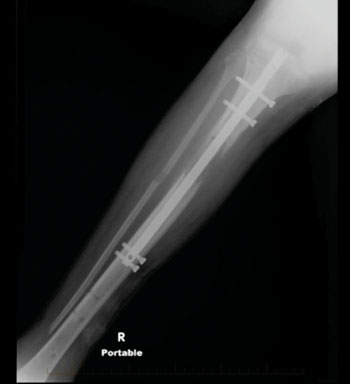Integrated Fixation Approach Advances Limb Salvage
By HospiMedica International staff writers
Posted on 29 Jul 2015
A new study suggests that integrated internal and external fixation can provide benefits in the reconstruction of post-traumatic tibial bone defects. Posted on 29 Jul 2015
Researchers at Loyola University Medical Center (Maywood, IL, USA) and the Hospital for Special Surgery (HSS; New York, NY, USA) treated 58 patients with post-traumatic tibial bone loss between January 2006 and December 2012, using the Ilizarov method. Of these, 52% were treated with the classic technique (external fixator alone), while 48% were treated with the integrated technique (a combination of an external fixator and plating or insertion of an intramedullary nail). Indications for use of the integrated technique were closed physes, no active infection, and a healed soft tissue envelope at the internal fixation site.

Image: Implanted titanium intramedullary nail fixator (Photo courtesy of Loyola University Medical Center).
The results showed that a mean of four surgical procedures to complete the tibial reconstruction were needed in both groups, with a similar incidence of unplanned surgical procedures. Patients treated with integrated fixation spent four months less with an external fixator (7 months versus 11 months). There was no difference in the severity or number of complications between both groups. Good to excellent function and bone scores were obtained in 100% and 98% of patients, respectively. The study was published ahead of print on May 5, 2015, in Clinical Orthopaedics and Related Research.
“Wearing an external fixator can irritate the skin and cause infections at the pin sites. Also, it's difficult to wear clothes over the device, and sleeping can be uncomfortable,” said lead author orthopedic surgeon Mitchell Bernstein, MD, of Loyola University Medical Center. “As soon as we get patients out of the external frame they feel better. Limb deformity surgeons are trying their best to make it a bit easier for patients, without compromising the safety of the procedure.”
The standard limb-lengthening technique, the Ilizarov method of distraction osteogenesis, requires patients to be fitted with a device called a circular external fixator, which consists of a rigid frame made of stainless steel and high-grade aluminum. Three rings surround the lower leg and are secured to the bone in order to manipulate bone fragments. Four times a day, the external fixator pulls apart two bone segments, and new bone tissue fills in the gap; as a result, the bone lengthens at a rate of about 1 mm per day.
Once the new bone tissue is formed, it takes several more months until it fully regenerates. In the standard Ilizarov limb-lengthening technique, the patient wears the external fixator until the bone completely matures, in order to support the weight of the limb. In the integrated fixation approach, the surgeon implants a titanium rod inside the bone as an internal fixator in order to reduce the amount of time the patient must spend in the external fixator.
Related Links:
Loyola University Medical Center
Hospital for Special Surgery














